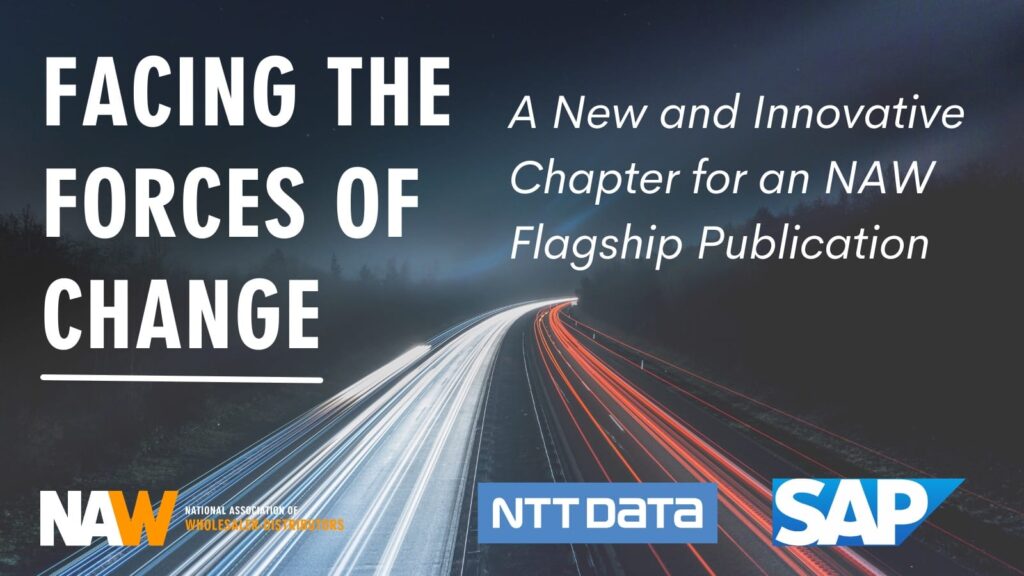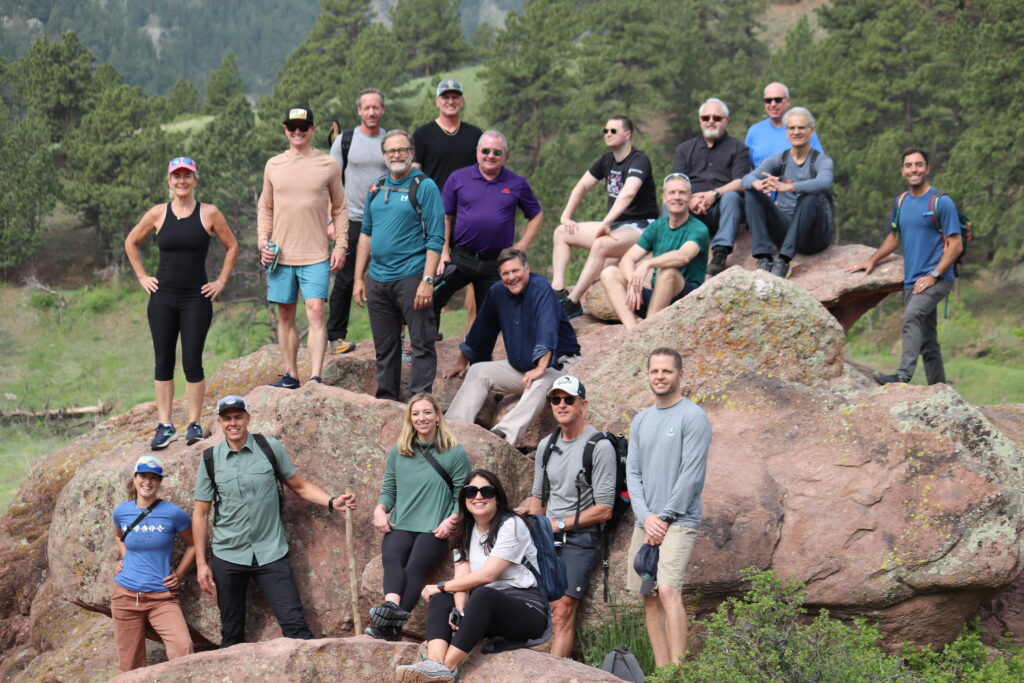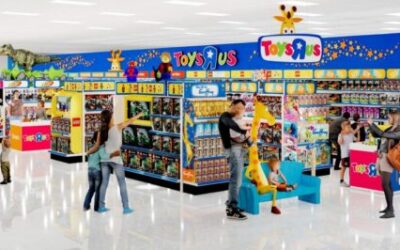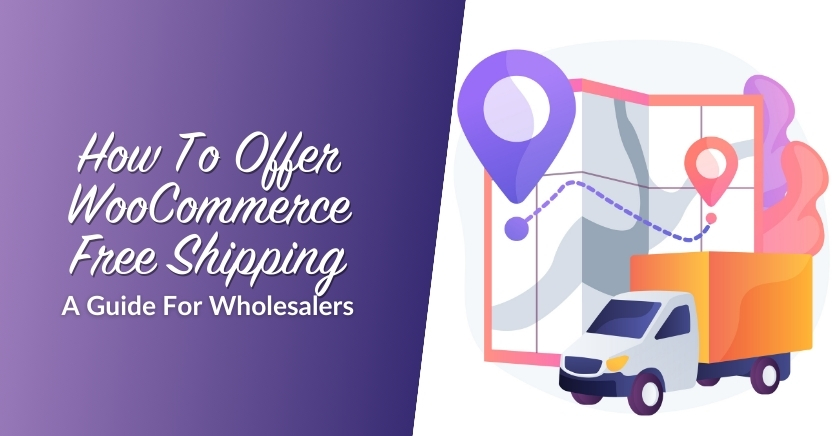Furthering the innovation journey


Aspirations direct our distributor innovations, so let’s aim high and build a supply chain worthy of our future.

Participants in the 2023 NAW BusinessOutside Innovation Forum.
This article explores the role of aspirations in innovating distribution. Do we want to do business differently? How high do we aim? I previewed my plans for this article in a previous newsletter, suggested that an “aspiration gap” holds back innovation, and asked for your feedback and help. The response was overwhelming. I hit a nerve. Most supply chain innovations are inward-looking by design or default, seeking to shore up business models, enhance productivity and profits, improve resiliency, and fend off disruption. This approach is entirely logical and rational. But truth be told, it is also defensive and short-sighted. Something is missing. As leaders of an $8 trillion industry, distributors manage a third of the economy, serving every business in every sector, and through them, every consumer and citizen. Can we do more? Can we create something new? Should we try? Do distributors have an opportunity—or even a responsibility—to improve the economy and society? In this edition, I suggest a way forward. It’s a start. Let’s get going.
Fueled by aspirations
As humans, our drive to live our lives differently separates us from every other living thing on the planet. We are not content to live within the boundaries of nature’s forces. We bend the world to our will, making mistakes and creating problems, but always striving for something better. We innovate because we are human, and our human aspirations direct our innovations. I asked ChatGPT, a tool that is essentially a repository of all digitized human knowledge, to explain why innovation is not possible without aspirations:
Innovation is fueled by the desire to achieve something greater, solve a problem, or break new ground; without aspirations to guide this pursuit, the motivation and focus required for innovative thinking are lacking. Aspirations act as the compass for creativity and ingenuity, directing efforts toward meaningful change and improvement.
Well, that’s interesting. We humans built a machine that can master massive data sets to tell us what we already know: we are fueled by our aspirations. Pursuing aspirations creates meaning, satisfaction, and happiness—as revealed by Arthur Brooks at the 2023 NAW Executive Summit (and discussed here.) It’s what we do. It’s what distributors should do. Aim high. Strive. Fail. Try again. We can’t help ourselves, so why hold back?
George Pattee, Chairman of Parksite, agrees and offers insights that cut to the core of distribution’s promise and peril as innovators:
Aspirations are like hope. Hope is the belief that something wished for can happen. Aspirations are more specific, the exact things we want to achieve. Without hope, we fail. Without aspirations, we cannot innovate. Too often, distributor hiring prioritizes people with solid business acumen. We don’t look for dreamers. And we don’t mentor our people to become innovators. At Parksite Academy, we strive to develop the skills to sustain our company over generations. As an industry, we need to do more. We must reach beyond today’s leaders and managers to attract and develop the next generation of innovators. We need a long-term, sustained, generational fight to avoid disruption.
As a human characteristic, aspirations are intensely personal and unique to every individual, team, organization, and perhaps, industry. Our motivations are simple and complex, known and unknown, influenced by genetics, upbringing, social environment, and experiences. If distributors are to put aspirations front and center in shaping innovations, we must all explore what drives them.
As a start, I offer five intrinsic motivations all humans share and explain how they may be relevant for modern distributors operating as intermediaries in a digital-age value chain. Motivations are like fertilizer for aspirations—providing dreams to sprout ideas and energy to help them grow and flourish. This is just a start; your motivations are likely different, but consider these:
- Competence. Distributors are known as skilled providers of products, often from inventory stocked in expertly managed warehouses. But they are much more than that. Distributors are local, people-centric businesses embedded in the communities they serve. Distributors thrive as committed, real-world problem solvers, and many channel this competence to achieve innovations, aiming high for the most significant effect.
- Community. Distributors live and work side-by-side with their customers in towns, counties, states, and regions. Distributors help businesses operate, contribute to economic health, and help communities create jobs, attract new companies, and generate wealth. Distributors innovate to help communities thrive because it is the right thing to do.
- Curiosity. Distributors know that what has made them successful in the past will not ensure their success in the future. A torrent of advice floods every leader’s inbox, offered by vendors, technology experts, startup founders, and more. But as intermediaries, distributors are at the center of commerce, pulling solutions together for customers and focused on day-to-day, practical progress. More and more, noticing change, exploring its cause, and considering new possibilities are the hallmarks of a high-performing distributor culture. Curious distributors see opportunities and innovate to make them happen.
- Regret. In social media, FOMO stands for “Fear of Missing Out,” which captures personal anxieties that flow from missing events, experiences, and opportunities. FOMO can lead to destructive behaviors, but with the right mindset, individuals can confront their fears and take action to overcome them. Does FOMO freeze distributors? Will distributors sit back and watch the future of work and markets evolve, accepting what happens? No. Leaders embrace their FOMO by overcoming doubts, investing in their people, and innovating to shape the future.
- Growth. Acquisitive distributors achieve growth through scale—amassing brand power, leverage to demand supplier concessions, and funds to invest in technology, talent, and process improvements. But as distributors aim higher to achieve their aspirations, new definitions of growth emerge. Growing people skills and hiring new talent may enable distributors to pursue new opportunities. Or, distributors may redefine what it means to be an intermediary—by bringing more than products together for customer solutions and innovating to create experiences centered on knowledge, data, artificial intelligence, sustainability, and more. Growth, achieved in old and new ways, will continue to motivate distributors, leading to new aspirations achieved through unheard-of innovations.
After revisiting motivations and resetting aspirations, distributors are ready to pursue disciplined acts of innovation. But one final mind shift is required. During times of epic change, best practices are risky. There is no tried-and-true innovation process because the sands are shifting. Customer preferences are unsettled. Known solutions may not work, or they may lead to less-than-expected outcomes. Suppliers are skittish—startled, fickle, and timid—retreating to their own devices and noncommittal about distributor partnerships.
In this environment, savvy innovators take a step back, reconsider what they know to be true, and build an innovation process around their “first principles,” the fundamental factors that guide innovations in good times and bad because they are at the core of their culture, capabilities, and of course, aspirations.
Talking with distributor leaders and innovators, I’ve identified several first principles. Again, these are a starting point. Every distributor must create their own, expressed in their own words:
- Profits are not our purpose. Distributors exist to create value for customers and suppliers. Success requires a clear purpose that each party cannot achieve by itself. Profits are the measure of operating a successful, purpose-driven company.
- Authentic customer conversations reveal sustainable business models. Manufacturers prefer to serve customers directly and won’t embrace distributors unless customers demand that they do. Distributors uncover their rightful roles (and innovations) by understanding customers better than suppliers.
- Helping customers is helping ourselves. Distributors will not survive by tweaking their business models to build fences around customers, eeking out profits to cover costs. The only path forward is to help customers get to their future, helping them innovate and then working back to redesign their business model for sustainable customer collaborations. Then, distributors can lead in redefining partnerships with traditional suppliers and new entities, providing essential value for digital-age customer solutions.
- We add value to data, not products. Soon, data will become more important than products for creating customer value. In part, that data will come from sensor-enabled smart products. But as intermediaries, distributors can leverage their data, add data from customers, and aggregate new data that illuminates the customer’s competitive environment, the costs of labor and knowledge inputs, and the ongoing evolution of markets and the economy.
- Our survival hinges on creating innovation hypotheses and testing them. Distributors must listen to expert advice about the future of technology, work, education, the environment, and more. Futurists are often practiced prognosticators, conferring confidence that they have the insights essential for making business strategies and decisions. But this is false. Distributors are on the front lines of serving customers, and through trial and error, distributors will determine the future. There is an art and science for innovating around hypotheses. Distributors must learn it, master it, and bet their future on it.
Final thoughts
So there you have it. Aspirations are essential for innovation. Individuals and organizations cannot act on their aspirations until they are in touch with the motivations that drive them. And, during a time of epic change, the established ways of innovating may not work, so it’s essential to revisit and confirm the “first principles” of how you understand customer needs and market functioning, as well as your business processes for generating ideas, testing hypotheses, and moving forward in reasonable steps, guided by a North Star. Distributors must do that, as individuals and organizations, to thrive in the digital age and build a supply chain worthy of our times.
But what can distributors do collectively, as an industry? Distributors have a long tradition of coming together to solve problems even as they compete with one another, leveraging industry associations for research, education, working groups, and, importantly, encouragement and leadership. As a Fellow, I know that NAW, the National Association of Wholesaler-Distributors, stands ready to step up and help distributors thrive. However, collaboration is a choice, and what distributors choose to do together is critical. To help kick-start this conversation, I offer two game-changing ideas:
- Create a “Y Combinator” for distribution and the supply chain’s innovators. YC provides seed money to accelerate tech startups. It is known for mentoring founders, helping them build a network, and offering them operational guidance around branding, business plan execution, and other ongoing support. To get started, distributors and the supply chain can build an initial program around a small cadre of innovators with founder-like characteristics: drive, passion, resilience, the ability to attract top talent, technical or domain expertise, and so forth. Money talks and funding innovators is an essential element of a successful program. NAW’s 2023 Innovators Summit will create conversations with startups and founders, an excellent starting point for designing distribution’s own Y Combinator.
- Reimagine value creation as an “act of creation.” Too often, value creation implies a financial, metric-driven, antiseptic, and almost scientific approach to serving customers. We should think about it differently, almost like art that resonates with the customer’s reality, aspirations, and journey. Every artist’s work is more than a product; it is an act of creation. An artist’s value is the outcome of a creative process that involves imagination, empathy, and intentionality. In the digital age, we are losing touch with what it means to do business as humans for humans. Distributors can lead every industry to implement technology in the service of customers’ and suppliers’ very human needs and aspirations.
NAW is working hard to reimagine Facing the Forces of Change® as a platform for helping distributors step up to today’s epic challenges and opportunities to innovate for their people, companies, communities, and society. Our work began at the 2023 NAW BusinessOutside Innovation Forum, and the photograph at the top includes everyone who came together to get the ball rolling. This article and the two that preceded it (here and here) are vital to this process, but your participation is essential as well. Please share feedback, ideas, experiences, and questions by commenting below or emailing me at [email protected] or Bart Tessel, NAW’s Chief Innovation Officer at [email protected].
Working together, we can set our aspirations, create authentic and revealing conversations, lean in to help customers, and invent the future of distribution as we build a supply chain worthy of our time. Let’s do it.
The post Furthering the innovation journey appeared first on National Association of Wholesaler-Distributors.











